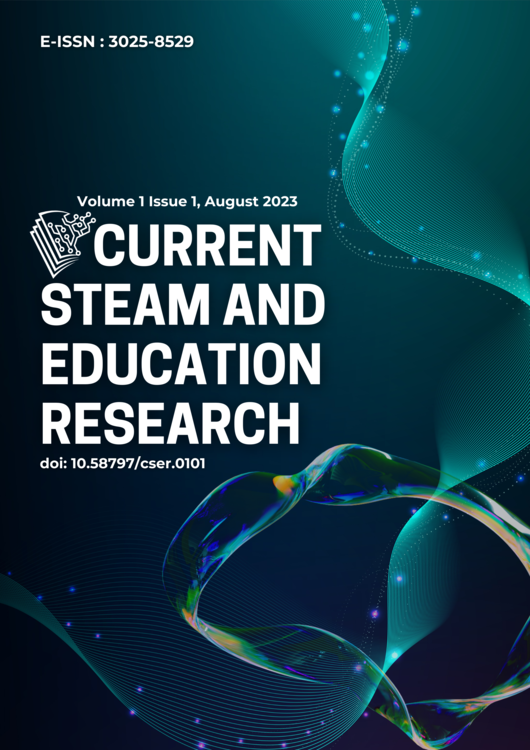Development of Special Relativity Material Learning Videos on Social Media Tiktok
DOI:
https://doi.org/10.58797/cser.010102Keywords:
learning video, social media, 4D, special relativityAbstract
The intensity of social media use by students is currently very high. TikTok social media is one of the social media that is often used because the videos that are presented are short and up to date. The purpose of this research is to develop physics learning videos on the TikTok platform with an introduction to physics concepts and cases in everyday life. This study uses the 4D method (Define, Design, Develop, Disseminate). The stages of the 4D method applied to this study are by analyzing needs and planning the concepts and content of video content. The product developed is in the form of a learning video on special relativity material and distributed via the social media TikTok. Media and material assessment instruments to measure validity by media experts and material experts. From the results of this study, show that learning videos on social media Tiktok is feasible to be implemented as a medium for learning physics in class 12 high school on special relativity material.
References
Alstein, P., Krijtenburg-Lewerissa, K., & van Joolingen, W. R. (2023). Designing and Evaluating Relativity Lab: A Simulation Environment for Special Relativity Education at the Secondary Level. Journal of Science Education and Technology, 1-14.
Amelia, R., Zulkarnain, I., & Hidayanto, T. (2022). Pengembangan Video Pendukung Pembelajaran pada Materi Matriks Untuk Kelas XI SMA Berbantuan Media Sosial “Tiktok”. Jurmadikta, 2(1), 89-99.
Goodarzimehr, V., et al. (2023). Special Relativity Search for applied mechanics and engineering. Computer Methods in Applied Mechanics and Engineering, 403, 115734.
Hafizah, S. (2020). Penggunaan dan pengembangan video dalam pembelajaran fisika. Jurnal Pendidikan Fisika, 8(2), 225-240.
Kamphorst, F., et al. (2019). Students’ preinstructional reasoning with the speed of light in relativistic situations. Physical Review Physics Education Research, 15(2), 020123.
Kamphorst, F., et al. (2023). An educational reconstruction of special relativity theory for secondary education. Science & Education, 32(1), 57-100.
Kementerian Pendidikan, Kebudayaan, Riset, dan Teknologi. (2022). Keputusan Kepala Badan Standar, Kurikulum, dan Asesmen Pendidikan (BSKAP) Nomor 033/H/KR/2022 tentang Dimensi, Elemen, dan Subelemen Profil Pelajar Pancasila Pada Kurikulum Merdeka. 199-203.
Kersting, M., et al. (2018). General relativity in upper secondary school: design and evaluation of an online learning environment using the model of educational reconstruction. Physical Review Physics Education Research, 14(1), 010130.
Kestin, G., & Miller, K. (2022). Harnessing active engagement in educational videos: Enhanced visuals and embedded questions. Physical Review Physics Education Research, 18(1), 010148.
Krane, K. S. (2019). Modern physics. John Wiley & Sons.
Kurniawati, I., Sarifudin, S., & Widawati, W. (2021). Analisis Kebutuhan Pengembangan Media Video Pembelajaran Mata Pelajaran Fisika Jenjang SMA. Jurnal Teknodik, 107-118.
Mana, L. H. A. (2021). Respon siswa terhadap aplikasi tiktok sebagai media pembelajaran bahasa indonesia. JIRA: Jurnal Inovasi Dan Riset Akademik, 2(4), 418-429.
Morrison, J. (2020). Modern Physics with Modern Computational Methods. Academic Press.
Nasution, A. K. P. (2020). Integrasi media sosial dalam pembelajaran generasi z. Jurnal Teknologi Informasi Dan Pendidikan, 13(1), 80-86.
Novisya, Dira, & Desnita. (2020). Analisis pengembangan video pembelajaran fisika berbasis ctl pada materi fluida. JIPI (Jurnal IPA & Pembelajaran IPA), 4(2), 141-154.
Pal, S., et al. (2019). A semi-automatic metadata extraction model and method for video-based e-learning contents. Education and Information Technologies, 24, 3243-3268.
Palmer, B. (2023). Teaching Einsteinian Physics in Schools. Teaching Science, 69(1), 55-56.
Pea, J. I., et al. (2021). Media Pembelajaran Fisika Berbasis Tik Tok Untuk Membantu Pemecahan Masalah Dan Kemandirian Belajar Peserta Didik. Jurnal Riset Kajian Teknologi dan Lingkungan, 4(1), 262-267.
Permana, H., et al. (2021). ‘Hallwachs and the negatively charged particles’-the development of education comics. Physics Education, 56(5), 055038.
Pujiono, Andrias. (2021). Media sosial sebagai media pembelajaran bagi generasi Z. Didache: Journal of Christian Education, 2(1), 1-19.
Puspaningtyas, N. D., & Ulfa, M. (2020). Improving Students Learning Outcomes In Blended Learning Through The Use Of Animated Video. Kalamatika: Jurnal Pendidikan Matematika, 5(2), 133-142.
Puspitarini, Y. D., & Hanif, M. (2019). Using Learning Media to Increase Learning Motivation in Elementary School. Anatolian Journal of Education, 4(2), 53-60.
Radin, A. G., & Light, C. J. (2022). TikTok: An emergent opportunity for teaching and learning science communication online. Journal of microbiology & biology education, 23(1), e00236-21.
Ramdani, N. S., Nugraha, H., & Hadiapurwa, A. (2021). Potensi pemanfaatan media sosial tiktok sebagai media pembelajaran dalam pembelajaran daring. Akademika: Jurnal Teknologi Pendidikan, 10(02), 425-436.
Safitri, A. A., Rahmadhany, A., & Irwansyah, I. (2021). Penerapan teori penetrasi sosial pada media sosial: Pengaruh pengungkapan jati diri melalui TikTok terhadap penilaian sosial. Jurnal Teknologi Dan Sistem Informasi Bisnis, 3(1), 1-9.
Swandi, A., et al. (2022). Designing a Sciences Learning Media Based on Website and Integrated with Youtube Videos. Kasuari: Physics Education Journal (KPEJ), 5(1), 53-64.
Tiwow, N., Wantah, E., & Mamentu, M. (2023). Analisis Kebutuhan Pengembangan Media Pembelajaran Berbasis Tiktok Pada Mata Pelajaran Komputer Akuntansi di SMK Negeri 1 Sonder. SEIKO: Journal of Management & Business, 6(1), 657-661.
Wijaya, A. I., & Romadhon, D. R. (2022). Penggunaan tiktok sebagai media pembelajaran fisika. Integrasi keilmuan dan keislaman melalui literasi digital Indoseia emas 2045.
Yulisa, Y., Hakim, L., & Lia, L. (2020). Pengaruh video pembelajaran fisika terhadap pemahaman konsep siswa SMP. Jurnal Luminous: Riset Ilmiah Pendidikan Fisika, 1(1), 37-44.
Yunita, E., & Suprapto, N. (2021). Analisis kelayakan video pembelajaran fisika berbasis platform YouTube pada materi Usaha dan Energi. IPF: Inovasi Pendidikan Fisika, 10(1), 21-31.
Downloads
Published
How to Cite
Issue
Section
License
Copyright (c) 2023 Wini Sholina, Dewi Muliyati, Rahmah Purwahida

This work is licensed under a Creative Commons Attribution 4.0 International License.
